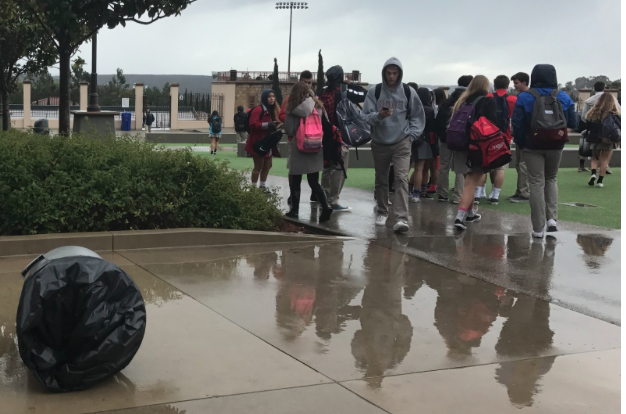Here today, gone tomorrow and back again
Students crowd around the knoll after school during a February afternoon rainstorm. Although rain is a major source of water in California, precipitation primarily arrives in the form of moisture. According to CCHS history teacher Mr. Don De Angelo, the fog and marine layer that rolls into California’s coastal region has been historically and geologically important to the well-being of crops.
March 21, 2017
While many Cathedral Catholic High School students worry about final exams, peer pressure, and dress code, CCHS Environmental Club leader Katie VanDeventer ’17 endures much anxiety regarding the golden state’s water situation.
Not so much anymore.
“I was very excited to hear California was almost entirely out of a drought,” VanDeventer ’17 said. “Our government and citizens have worked hard to push us out of this environmental situation through conservation and new legislation.”
Parched by years of drought, California seemed mired in inescapable drought conditions with total monthly rainfall barely exceeding one inch of total rainfall in most San Diego County regions. However, unexpected heavy rainstorms completely flipped drought conditions around in a matter of weeks, as most Southern California coastal areas averaged around 8-9 inches of rainfall during the month of January alone.
According to the U.S. Drought Monitor, only 24.46 percent of California was experiencing abnormally dry or moderate drought conditions as of March 7. But just one year ago, drought conditions were recorded officially in 99.57 percent of the state. However, the much anticipated El Niño finally came around and saved California from a scorched doom.
Or did it?
CCHS AP environmental science and biology teacher Mrs. Terry Annicchiarico explains that the El Niño did in fact occur last year, but it turned out to be a moderate El Niño and nothing like the monster El Niño meteorologists predicted.
In the same sense, the rain storms that brought California out of its drought earlier this year should not be mistaken for El Niño storms, Mrs. Annicchiarico said.
“The El Niño happens because there’s a lot of really warm ocean water that then condenses and puts a lot of moisture into the air,” Mrs. Annicchiarico said. “The tradewinds have to slow down or stop, and then the Pacific Ocean actually flows back toward Peru where the El Niño starts. This year, we don’t have that condition of the tradewinds slowing down, so it’s not considered an El Niño year.”
According to Mrs. Annicchiarico, the recent rainstorms are a result of warm ocean temperatures, which produce condensation that is ultimately picked up in the air and turns into the rainstorms that have been passing over California.
The downside to such excessive rain is that landslides and floods often occur due to the impermeable soil the drought caused. This situation was best exemplified last month when San Jose, California flooded.
Overall, California desperately needed the rainfall.
Drought conditions may officially be over in the majority of California, but it is important to remember another drought is inevitable.
“People forget that we’re a semi-arid desert,” Grossmont College professor and CCHS government teacher Mr. Don DeAngelo said. “We’re an area of the country that should always be mindful of the fact that water shortages can happen in an instant. This very same time next year, we could be in a drought.”
There are numerous reasons why California keeps frequently experiencing droughts.
“We’ve all moved in here and taken over,” Mr. DeAngelo said. “San Diego county should have maybe 500 thousand to 1 million people, and we have 3.5 million people living here. It’s just like all the people living in Arizona. There’s no reason for people to be in Arizona from a purely water reality.
“But everybody wants to be where there’s less cold.”
Since people do not treat water as a rare, valuable substance, California will keep enduring drought conditions, Mr. DeAngelo said.
Several initiatives have been taken in San Diego County in order to ensure water conservation. For instance, the construction of the desalinization plant in Carlsbad and the San Clemente Reservoir both work toward conserving fresh water.
Conversely, the Oroville Dam spillway disaster resulted in the loss of 41,000 cubic feet of water per second that California could have used during the next drought, The Mercury News reported.
Moreover, the subsidized bottled water industry wastes table water and sells water for a cheap price. People believe it is their constitutional right to access water, but that detracts from the point that water should be sold as a rare commodity, Mr. DeAngelo said.
“The fact of the matter is, if water is not priced the way it’s supposed to be priced, then there’s always going to be these crises,” Mr. DeAngelo said. “Then we’re going to be okay and then we’re going to not be okay and then we’re going to be okay. And that should not be how the system works.
“Your mentality should be constant.”
Lastly, people should not be influenced by what Republicans and Democrats have to say about water conservation.
“Republicans want to have more access to other water sources, and they want the water on the cheap,” Mr. De Angelo said. “So they’re always trying to downplay these things and making it an issue about water distribution. Democrats, on the other hand, take every single drought as an issue of climate change, and they hype it up because that allows them to pass all kinds of laws.”
VanDeventer is just glad she does not have to worry as much for awhile.






















































